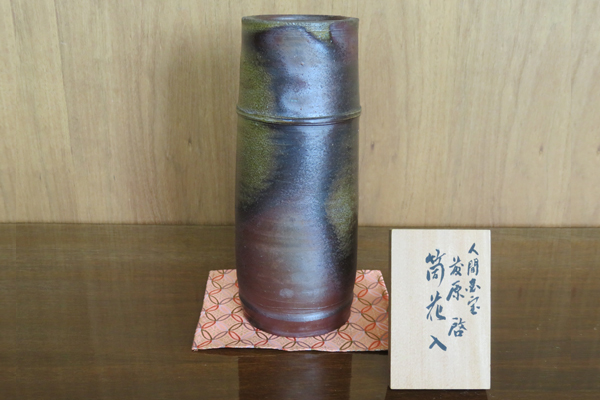Famous Authors of Bizen Pottery
Kaneshige Toyo: real name “Isamu” (January 3, 1896- November 6, 1967)
He was born as the eldest son of Kaneshige Baiyo (Makisaburo), kiln principal, in Imbe, Bizen City.
Kaneshige Toyo was designated the first holder of Living National Treasure in Bizen Pottery in 1956 (Showa 31st).
He was an expert of a handwork. He was a far-sighted person and often appreciated a masterpiece of Bizen Pottery in the Momoyama Period by associating with a master craftsman in every region of the country and an elegant pursuits person.Kaneshige Toyo thought the future Bizen Pottery should “returns to Momoyama” and left the excellent works which drew near to the ones in the Momoyama Period.In order to reproduce the earth in Momoyama Period, he examined the earth, shaped the kiln and built the original climbing kiln.
Fujiwara Kei: real name “Keiji” (February 28, 1899- November 12, 1983)

Fujiwara Kei was born as the 3rd son of a rural family in Honami (formerly Iri village of the Wake Area) of Bizen city, Okayama prefecture.
Showing considerable talent in the composition of Haiku and novels in from his boyhood, he went to Tokyo in the 8th year of Taisho (1919) to make his mark as a novelist. However, in the 12th year of Showa (1937) he gave up literature and returned to his birthplace.
In the 13th year of Showa, Fujiwara Kei started out on the path to Bizen pottery having been persuaded by Atsuo Hakucho, the younger brother of famed novelist Masamune Hakucho, who lived closeby in the neighborhood. At the age of 39, he began his career as a potter relatively late.Having recieved guidance from such figures as Kaneshige Too and Kitaoji Rosanjin, Fujiwara Kei had already progressed in making pottery and was well known for his simple and easy-going style, standing in contrast to his teacher Kaneshige Toyo.
Having remodelled the beauty found in the miscellaneous wares of the Kamakura and Muromachi period with his distinct modern sensibilities, Fujiwara Kei was designated as ‘Living National Treasure’ in the 45th year of Showa (1970).Fujiwara Kei who displayed new developments in Bizen pottery that had been inherited from ancient times imparted a huge influence on successive artists in Bizen pottery.
Yamamoto Toshu: real name “Masao” (April 24, 1906- April 22, 1994)

Yamamoto Toshu was born in Imbe, Bizen City.
At the age of 15, Yamamoto Toshu watched and learned from the kiln sites he went to and at the age of 27 he became an independent artist in Bizen pottery.
From excelling in his skill on the throwing wheel (rokuro), he came to be called the ‘master of the throwing wheel’ and his technique gave birth to a sensitivity that produced elegant, highly refined tea wares.What Yamamoto Toshu drew upon were the tea vessels of the Azuchi-Momoyama period. These represented was the golden age of Bizen pottery that was labelled ‘Momoyama Bizen’.
whilst being influenced by Kaneshige Toyo, Yamamoto Toshu sought out the secrets of ‘Momoyama Bizen’. And from his superior techniques on the throwing wheel he produced original tea wares.In the 62nd year of Showa (1987) the high level of skill shown by ‘Toshu’s tea wares’ were recognized and he was designated as a ‘Living National Treasure’. This was when Yamamoto Toshu was an astounding 80 years of age.
Fujiwara Yu (June 10, 1932- October 29, 2001)

Fujiwara Yu was born as the eldest son of the Bizen potter Fujiwara Kei in Honami (formerly Iri village of the Wake area) in Bizen city, Okayama prefecture.
Although he had a handicap of 0.03 vision in his right eye and could not see at all with his left, it was his father who urged him strongly to go to a normal school alongside able-bodied personas and to progress to Tokyo University.Much in the same way as his father, he it is said that he was passionate about such things as literature and music in his youth.Whilst still valuing the tradition of Bizen pottery and pursuing the creation of wares burtsting with a new kind of sensitivity, Fujiwara Yu was designated a ‘Living National Treasure’ in the 8th year of Heisei (1996).Furthermore, Fujiwara Yu hosted the exhibition on the “possible fired effects found in ceramics”, served as the chair of the comittee on implementation, and poured his efforts into the discovery of new talent and nurturing of the next generation of potters.
Isezaki Jun (February 20, 1936 -)

Isezaki Jun was born the second son of the eminent Bizen pottery artist Isezaki Yozan in Imbe of Bizen city, Okayama prefecture.
In the 34th year of Showa (1959), He graduated from the Special Arts Department of Okayama University’s School of Education.
Whilst pursuing the history of Bizen pottery by re-establishing the use of the medieval kiln known as ‘Anagama’ or ‘cave kiln’, he frequently interacted frequently such artisans and aesthetes such as Isamu Noguchi (1904-1988) and Masuo Ikeda (1934-1977) and has broken new ground in the world of Bizen pottery.Taking charge of the remodelling of tradition, Isezaki Jun was designated a ‘Living National Treasure’ in the 16th year of Heisei (2004).
What makes Isezaki Jun so unique is his modern sense in the modelling of his works.From traditional tea vessels to objet works of art and installations, he has created novel works that have a huge forum. His activity is has not only caught the attention of those in Japan but also from those abroad.Isezaki Jun has also created a Bizen ceramic relief mural on a wall of the Japanese Prime Minister’s official residence.
Bibliography:
“The Appeal and Technique of Bizen Pottery” written by by Yamamoto Yuichi (published by Fukuro Shuppan)
“Bizen – A Guide for Japanese Pottery and Kiln Sites” written by Uenishi Setuo and Nakamura Akio (published by Tankosha Publishing)
Animation offered by:Bizen Activate Consortium (BAC)
Pictures offered by:Taiga Mori, Naoyuki Morimoto
Photography collaborated by:Gallery Mugen-an, the Bizen Chamber of Commerce and Industry


 日本語
日本語










